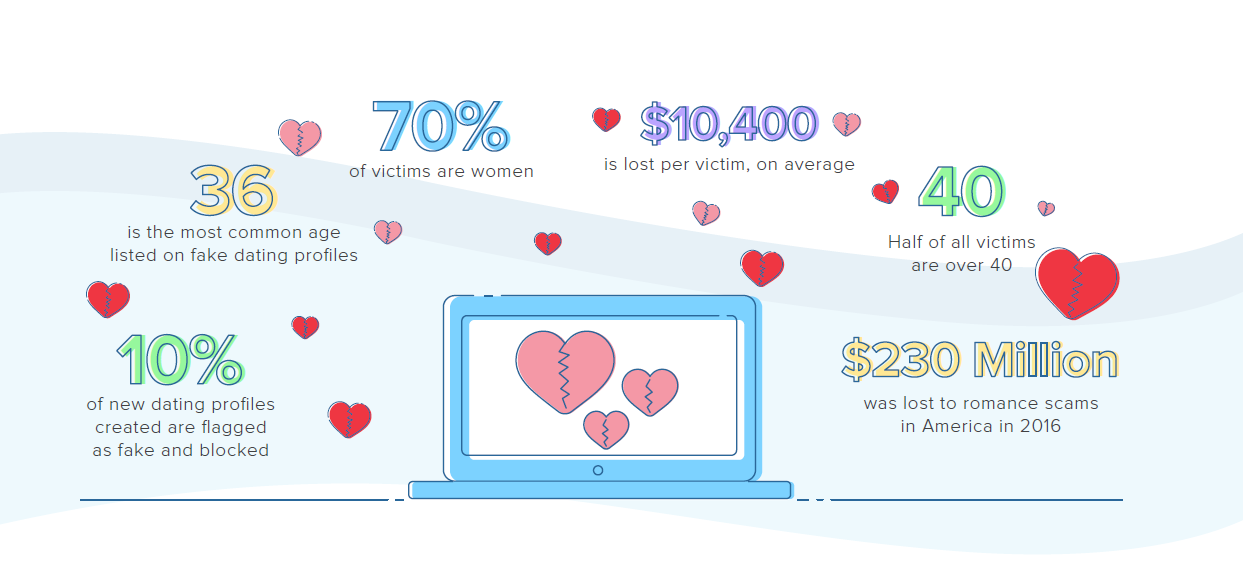Fools for Love: ML Defends against Dating Site Fraudsters

Source: Google Art Project (public domain)
Valentine’s Day is a time to celebrate and, for the fortunate among us, enjoy that most intoxicating of human emotions: romantic love. But amid the red roses and candlelit dinners we must also be wary of love’s potential for online treachery. If “love is the wisdom of the fool and the folly of the wise,”** it’s also a tool for cyber criminals who “hath power to assume a pleasing shape”** on dating sites and exploit love’s tendency to make fools of us all. But now, machine learning algorithms are coming online to fend off cyber-seducers, helping us see what love makes us blind to and safeguard our money and digital identities, if not our hearts.
Growth in the $3 billion online dating industry is surging. In 2016, according to Pew Research, 15 percent of American adults reported they used online dating sites and mobile apps, up from 11 percent in 2013, and usage is higher across every age group. On the Zoosk site, which has 35 million members, 3 million messages are exchanged during an average day. Worldwide, there are 75,000 sites, and 66 percent of users report they’ve succeeded in finding a partner.
But behind that growth trails the foul dust of internet dating fraud, most of it involving scammers building trust in a fake romantic online relationship whose objective is to convince a victim (70 percent are women) to give the fraudster money. It totals up to big money. According to the FBI, romance scams cost consumers more money than any other kind of internet fraud. In 2016, the last year for which data is available, consumers lost more than $230 million this way, an average loss per victim of $10,400. In the U.K., the National Fraud Intelligence Bureau reported that in 2017 there were 3,889 romance fraud victims, who handed over £39 million. And only 15 percent of fraud victims report their losses to the FBI, so the real number could be higher.
It’s estimated that fully 10 percent of new dating profiles are flagged as fake and blocked. In 2011, one of the most popular sites was sued based on accusations of high numbers of fake profiles.
The growing numbers of users, messages and fraudsters invites the analytical power of machine learning to combat scams. Zoosk, for example, a global online platform available in more than 80 countries and translated into 25 languages (and with reportedly the top grossing online dating app in the Apple App Store) is a customer of Sift Science, and its Digital Trust Platform, which has built a big data ecosystem collecting data on tens of millions of end users at its approximately 6000 customer merchant web sites (Match.com, Twitter, Airbnb, Yelp!, Instacart, Jet), and then developed fraud detection algorithms.
According to Sift Science, the company analyzes more than 150 million events per day and generates more than 14 million end user “risk scores,” which matches user behaviors with those associated with fraudsters. As a user’s risk score goes up, Sift Science notifies its customer that it may have a scammer in its presence; it’s then up to the merchant dating site to decide what action to take, such as closing down the user’s profile or moving the profile to its fraud prevention staff for manual monitoring.
Kevin Lee, trust and safety architect at the 145-employee company, told EnterpriseTech that as the Digital Trust Platform gathers and analyzes massive amounts of user behavior, it’s constantly learning new cues and clues of cybercriminals. For example, the earmarks of a dating site fraudster include the creation of multiple sites, profiles without photos of the user, the rapid creation of profiles by cutting and pasting profile information, and daily contact of unusually high numbers of people.
“The normal person trying to meet someone might contact three or four people a day,” Lee said, “but the scammer will contact hundreds of people. That’s a red flag for us.”
The Sift Science platform drills into the particulars of the cybercrook’s world, gaining knowledge of fraud commonalities. For example, its algorithm connected the dots between fraudsters and the kind of cell phone they tend to use for mobile dating apps.
“ We were able to extract signals that an iPhone 5 is 12 times more risky than an iPhone 7,” said Lee, “and the reason is because the iPhone 5 are somewhat out of date…, it’s really cheap, they’re easily available and you don’t need a lot of horsepower to run dating apps.”
iPhone 8’s, on the other hand, are relatively expensive, and they’re newer and thus not as available.
“Fraudsters have a business to run,” he said. “If you’re a fraudster, why invest in fancy new equipment when this slightly out-of-date equipment can get the job done? We’re able to realize and put hard numbers behind the likelihood of fraud based on the device you’re coming from, or even your IP address or your device, and come up with a profile based on that activity before people have even posted anything yet.”
There are many flavors of romance scam:
- “Catfishing” is the most popular scam, in which fake profiles use fabricated information (or information stolen from real people) and is used to “catfish” others and conduct romance scams, spam or carry out other harassment of legitimate users.
- Monetary requests: Romance scams happen when a fraudster builds confidence in a legitimate user through extensive communication over several weeks and months, after which the fraudster will ask for monetary payment often claiming it is for a medical emergency or other dire need.
- Blackmail: Other scams include blackmail activities where explicit videos or images are recorded by fraudsters and used to extort money from legitimate users.
At Zoosk, Tal Yeshanov, payments and risk manager, partnered with Sift Science in part because it needed a solution that could keep pace with the real-time nature of Zoosk’s service and scale as its user base expands. Zoosk integrates Sift Science's findings via Sift Score API into Zoosk's existing management system, and the team now has more data and is more efficient.
“We've seen Sift's accuracy improve as we've continued to use the solution,” Yeshanov said. “Sift Science's real time machine learning model enables us to get accurate data quickly, thus allowing us to make informed decisions in real time.”












